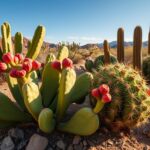The Sonoran Desert stretches across Arizona, California, and northern Mexico. It’s a place where daytime temperatures can hit over 40°C (104°F) and nights can freeze. You might think nothing could survive here. But, desert plants, arid flora, and xerophytic vegetation have found ways to live.
These plants, like the famous saguaro cacti, agave, and yucca, have amazing survival skills. They use deep roots and special water storage to make the most of every drop of water. They are true survival experts in one of the toughest places on Earth.
Key Takeaways
- Deserts are known for their extreme heat, little rain, and poor soil, making them tough for plants.
- Desert plants have come up with incredible ways to survive, like deep roots and special water storage.
- The Sonoran Desert, in Arizona, California, and northern Mexico, is full of desert plants, arid flora, and xerophytic vegetation.
- Plants like saguaro cacti, agave, and yucca show how well they can survive without much water.
- Learning about desert plants teaches us about nature’s resilience and creativity.
Introduction to Desert Plants
Deserts are tough places, but they’re also home to a wide variety of plants. These xerophytic vegetation have learned to survive with little water. They’ve developed ways to get, store, and save water in the harsh sun and dry conditions. Desert plants have deep roots, waxy coatings, and organs that store water. These features help them not just survive, but also flourish in the arid zone flora.
Adaptation Strategies for Harsh Environments
Desert plants have many ways to deal with their tough environment:
- Extensive root systems that can tap into deep groundwater sources
- Water-storing organs, such as the swollen trunks of baobab trees or the fleshy leaves of succulents
- Waxy coatings and small, narrow leaves that minimize water loss through transpiration
- Specialized photosynthetic pathways, like Crassulacean Acid Metabolism (CAM), that reduce water usage
- Dormancy strategies, such as annuals that complete their life cycle during brief periods of rainfall
These strategies help desert plants survive where other plants can’t. By learning about desert plant adaptations, we can see how tough and diverse xerophytic vegetation is in arid zone flora.
Deep Roots of Mesquite Trees
The mesquite tree is a true desert survivor. It has adapted to the harsh environment with an impressive root system. These plants can reach roots over 50 meters deep, accessing water far from other plants.
This lets mesquite trees survive long droughts when the topsoil is dry. They can get water from deep underground.
Tapping Into Underground Water Sources
Mesquite trees are experts at finding deep groundwater. Their roots go over 100 feet deep into the earth. They search for water that is hidden beneath the surface.
This skill keeps them green and productive when there’s little surface water. The deep roots show how resilient these trees are.
Their roots are the deepest of any tree, letting them reach water others can’t. This makes them crucial in desert ecosystems. They provide food, shelter, and balance in tough environments.
“The mesquite tree is a true survivor, its deep roots tapping into the hidden water sources that sustain it even in the driest of conditions.”
As our climate changes and water gets scarcer, the mesquite tree’s ways of surviving are very useful. By studying these plants, we learn how life can keep going in tough places.
Seed Dispersal Strategies
In the desert, plants have found clever ways to spread their seeds. This ensures their species can survive. Some plants use the wind, while others have special methods.
The mesquite tree is a great example. These trees produce pods full of nutrients that animals love. When animals eat these pods, they carry the seeds away in their feces. This helps spread the seeds across the desert.
This method, called animal-mediated seed dispersal, is key for many desert plants. It lets seeds travel far, finding new places to grow. This is important in the tough desert environment.
| Seed Dispersal Strategy | Advantages | Examples |
|---|---|---|
| Wind dispersal | Efficient for covering long distances, allows for widespread distribution | Dandelion, Milkweed |
| Animal-mediated dispersal | Ensures seeds reach new, suitable habitats, protects seeds from predation | Mesquite, Cactus |
| Explosive/Ballistic dispersal | Propels seeds away from parent plant, reduces competition | Lupine, Pea |
Learning about desert plant seed dispersal helps us understand how these plants survive. Their unique ways of spreading seeds are key to their success in the desert.
The Resilient Creosote Bush
In the harsh desert, the creosote bush stands out as a survivor. It thrives in tough conditions, showing how desert plants can endure. This shrub is a symbol of desert life’s strength.
Cloning for Survival
The creosote bush doesn’t just spread through seeds. It uses a clever method called clonal growth. New branches grow roots of their own, creating large colonies around the oldest parts.
One famous example is the “King Clone” in the Mojave Desert. It’s over 11,700 years old, making it one of Earth’s oldest living things. This plant shows how the creosote bush can last for millennia.
Creosote bushes grow in different deserts, like the Chihuahuan, Sonoran, and Mojave. They adapt well to dry lands. Indigenous people have used it for medicine for centuries.
Today, the creosote bush is being studied for its potential in cancer treatment. This shows its ongoing importance and value.
The creosote bush shows how nature’s toughest creatures can survive and even flourish. Its story teaches us that life can thrive in the most challenging places.
Cacti and Their Water-Storing Stems
Cacti are famous for their thick stems that store water and their spines that keep predators away. The saguaro cactus can grow over 20 feet tall and stores a lot of water in its stem. This helps them survive long without rain by using the water stored inside.
Succulent plants, like cacti, have special cells for storing water. Aloe vera plants have a thick skin to keep water in and vascular bundles to move water and nutrients around. Opuntia cacti, or prickly pears, have fleshy stems with spines. They are invasive, can live in salty places, and are hard for animals to eat.
Cacti stems make their own food and keep water in through photosynthesis. Their spines help reduce water loss and can catch dew for the roots. Many cacti and succulents also use chemicals to keep away herbivores and diseases. For example, the African Milk Tree and Euphorbia milii have latex that can stick to an animal’s mouthparts.
| Cactus Genus | Characteristics |
|---|---|
| Opuntia | Produce edible prickly pears |
| Mammillaria | Native to North and Central America, low-maintenance |
| Ferocactus | Native to North America, produce colorful flowers |
| Gymnocalycium | Small to medium-sized, have vibrant blooms |
| Trichocereus | Known for their large, colorful flowers |
| Parodia | Have eye-catching globular shapes and colorful flowers |
| Schlumbergera | Include the Christmas Cactus and Thanksgiving Cactus |
Cacti can store water in their stems and leaves, and they use spines instead of leaves to save water and keep away animals. There are over 2,000 different kinds of cacti, from small to tall ones. These plants grow slowly and need at least four to six hours of sunlight a day to bloom well.
Succulents: Fleshy Water Reservoirs
Succulents are fascinating plants that have adapted to live in dry places. They come from over 60 different plant families. These plants show how well they can survive in tough desert conditions.
These plants store water to survive. Many, like aloe vera, have thick leaves or stems that hold water. This helps them last through dry spells.
Waxy Coatings for Water Conservation
Many succulents also have a waxy layer on their leaves and stems. This layer helps keep water from evaporating. It’s a way for the plants to save water.
Cacti are a type of succulent that have taken this to an extreme. They have spines and areoles to protect themselves and save water. They also have a special way of making food called CAM, which helps them use less water.
| Succulent Plant | Water Content (%) |
|---|---|
| Cucurbita foetidissima (root) | 81% |
| Ficus petiolaris palmeri (caudex) | 68% |
| Parkinsonia microphylla (tree) | 53% |
Succulents show a wide variety, from the big Saguaro cactus to the small Echeveria and the bright Aloe vera. Each has its own way to save water and live in tough places.
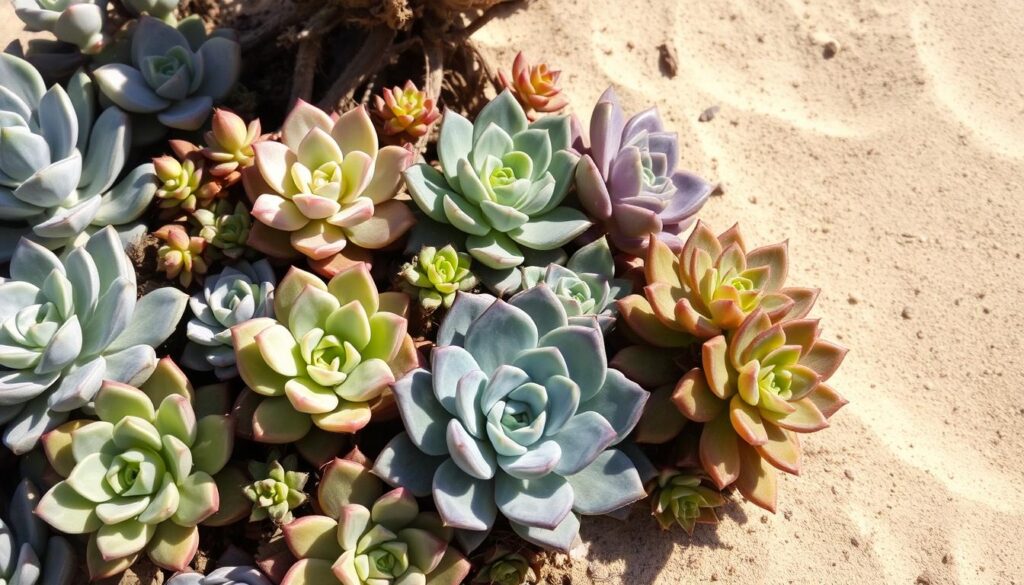
“Succulents are the ultimate survivors in the plant kingdom, thriving where others would wither.” – Botany Expert, Jane Doe
Acacias and Their Long Roots
Acacias, the national tree of Israel, are amazing desert plants. They have adapted to live in tough conditions. Their secret to survival is their deep roots.
These roots are long and deep, reaching deep underground. This lets them find water that other plants can’t reach.
These deep roots help acacias survive in deserts with little water. They can grow fast, reaching 20 to 30 feet tall. This is because they can use a lot of underground water.
Acacia trees have many other ways to stay strong. Some have sharp thorns to keep animals away. Others can handle the heat and bloom early in spring.
For example, the Knifeleaf acacia has sweet-smelling flowers. The Koa acacia in Hawaii is very tall. These show how diverse the Acacia family is.
| Acacia Variety | Height | Bloom Period | Key Characteristics |
|---|---|---|---|
| Bailey Acacia | 20-30 ft (6-9 m) | Winter | Bright yellow blooms, protected by thorns |
| Guajillo (Texas) Acacia | 5-12 ft (1-4 m) | Early Spring | Heat-tolerant, fragrant white flowers |
| Knifeleaf Acacia | 10-15 ft (3-4 m) | Early Spring | Sweet-smelling yellow blooms |
| Koa Acacia (Hawaii) | Up to 60 ft (18 m) | Spring | Pale yellow flowers, native to Hawaii |
There are over 1,300 types of Acacia trees around the world. They show how plants can adapt and survive in dry places. Their deep roots are amazing, letting them live where many plants can’t.
Desert Plants
The desert is full of desert flora, each with special ways to live in the tough arid zone vegetation. You might know about mesquite, creosote bush, cacti, and succulents. But there’s more to see in the desert, like xerophytic plants that are really interesting.
The yucca has leaves that catch water, helping it survive in dry places. Acacias have roots that go deep to find water underground. These plants, and many others, have found ways to live well in very tough conditions.
- Yucca: Features sharp, water-capturing leaves that help the plant conserve moisture in arid climates.
- Acacias: Have deep, water-seeking root systems that allow them to access underground water sources.
- Bursera fagoroides: A succulent tree known for its swollen trunk, peeling bark, and fragrant leaves.
- Aloe dichotoma: Can grow into a tree-like structure over time, with a smooth and striped trunk that stands out.
- Adenium arabicum: A type of desert rose characterized by a squat and broad caudex and showy flowers.
These are just a few examples of the amazing desert flora that live in tough places. Learning about their ways helps us appreciate the desert’s beauty and strength.
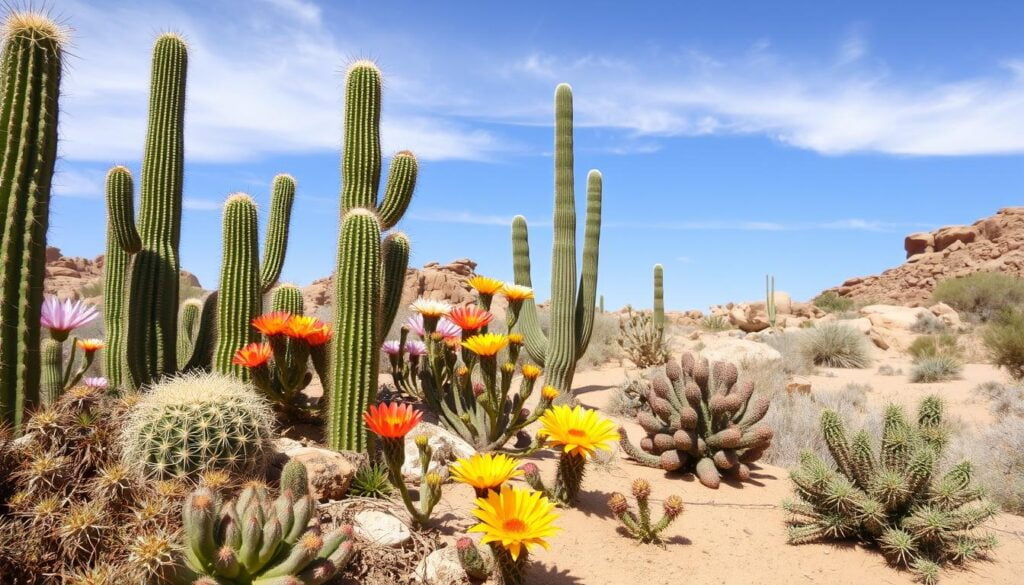
“The desert is not a lifeless place. It is a sanctuary for some of the most resilient and fascinating plants on Earth.”
Yucca’s Sharp Leaves for Moisture Capture
The yucca is a standout in the desert plant world. Its long, sharp leaves are more than just for looks. They play a key role in capturing moisture, like dew or rain, for the plant.
Yuccas love bright, indirect sunlight, making them perfect for sunny spots indoors or outside. They do best in dry soil and can rot if the soil gets too wet. Keeping the temperature between 60°F to 80°F (15°C to 27°C) helps them grow well.
There are about 40 types of yuccas, each with its own growth rate and size. But they all are great at saving water. Some yuccas can grow into tall “trees” with a big trunk and branches on top.
The sharp leaves of the yucca also protect it from animals that might eat it. This makes it tough to survive in the desert. It shows how well this desert plant can adapt.
“Yuccas are true masters of moisture capture, their sharp leaves funneling every precious drop down to their thirsty roots.”
Looking at the yucca’s beauty or its water-saving ways is amazing. This desert plant shows how nature can solve problems in clever ways. Its special leaves make it a survivor in dry places, great for any garden or indoor space.
Photosynthesis Adaptations
Desert plants have evolved amazing ways to make their own food, even in dry places. They use less water by taking in carbon dioxide at night. This is when the air is cooler and holds more moisture.
This method, called Crassulacean Acid Metabolism (CAM), helps them survive in the desert. It lets them make food at night and lose less water. This is crucial for saving water in dry areas.
Nighttime Carbon Dioxide Intake
These plants take in carbon dioxide at night and store it as malic acid. Then, during the day, they release this CO2 for photosynthesis. This way, they keep making food without losing much water.
This helps them stay ahead in the desert. They make food at night, avoiding competition with daytime plants. This means they get more sunlight and water.
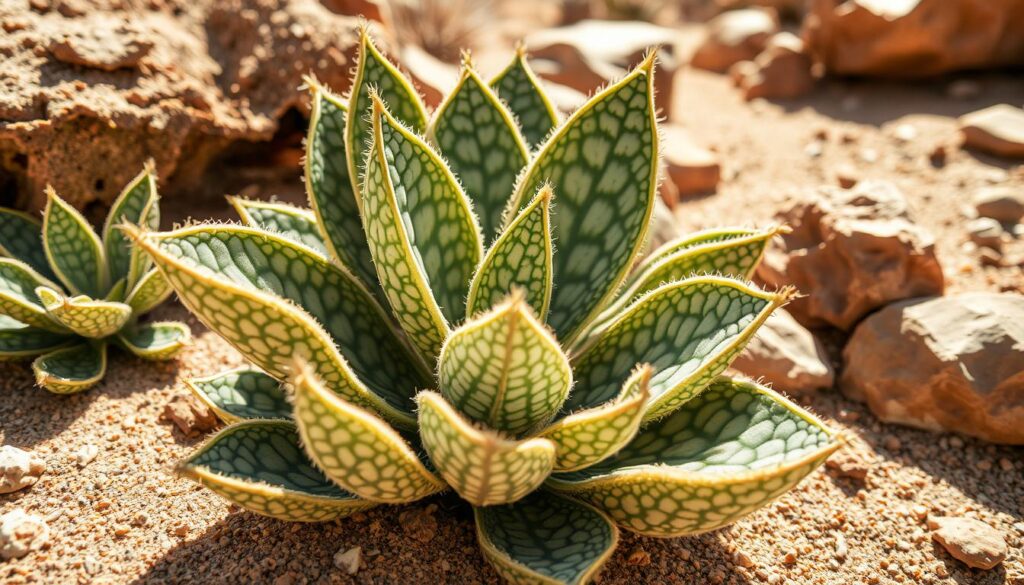
These plants also benefit from their nighttime photosynthesis. They work with night pollinators like moths and bats. This increases their chances of making more plants.
Plants like Aloe, Agave, and Sempervivum, and cacti like Saguaro, Barrel, and Prickly pear, are great examples. They’ve learned to save water with their special photosynthesis. These plants show us how to survive in tough places.
Leaf Modifications for Water Retention
Desert plants have amazing ways to save water, and changing their leaves is a big part of it. These plants have special leaves that help them lose less water through evaporation. This is key to their survival in the desert.
Many desert plants have small, waxy leaves that bounce sunlight back. This cuts down on heat and evaporation. Some plants take it further by losing their leaves and using their stems for photosynthesis. This cuts their water use even more.
Desert plant leaves also have special features to keep water in. Some have sunken stomata, which are the tiny openings for breathing, to stop more water from escaping. Others have hairs on their leaves that slow down water loss.
| Leaf Adaptation | Function | Examples |
|---|---|---|
| Small, waxy leaves | Reflect sunlight, reduce evaporation | Creosote bush, mesquite tree |
| Sunken stomata | Limit water loss through transpiration | Agave, yucca |
| Trichome (hair) coverage | Create a boundary layer to slow water loss | Sage, artemisia |
These desert plant leaf adaptations show how these plants can live in very dry places. By retaining water and cutting down on transpiration, they can make it through tough times.
Water Storage Organs and Caudexes
Desert plants have evolved a clever way to survive the harsh desert conditions. They use water storage organs called caudexes. These are thickened trunks or stems that hold water for the plant during droughts.
Caudex plants have stems that can store a lot of water. This lets them survive long dry periods. They are becoming more popular as people look for unique plants for their gardens.
The word “caudex” comes from Latin, meaning tree trunk or stem. It shows how important these structures are for the plants’ survival. Caudex plants are a type of succulent, storing water in their leaves, stems, or roots.
These plants also have other ways to save water, like special leaves and waxy coatings. The Desert Rose and Elephant’s Foot are just a few examples of the diverse caudex plants out there.
“Caudex plants are the true water storage experts of the desert, with their swollen stems holding the key to their incredible resilience.”
Looking after caudex plants is special. They need the right amount of water, light, temperature, and soil. It’s important to make sure they have good drainage and the right amount of light. Also, watch out for giving them too much water.
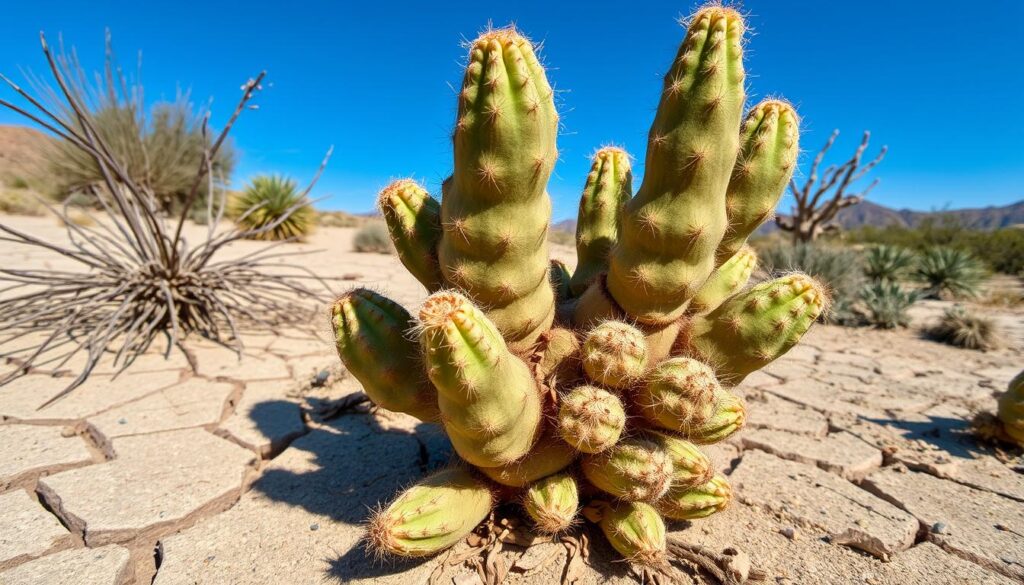
Desert plants, especially caudexes, show us how life can adapt to tough conditions. By learning about these plants, we can see how nature is full of resilience and creativity.
Repelling Competitive Plant Species
In the desert, plants fight hard for water. Some desert plants use allelopathy to win. They release chemicals that stop other plants from growing. This way, they keep the water they need to survive.
Allelopathy is a clever way for desert plants to beat the competition. They use chemicals to stop other plants from growing. This helps them get more water and stay ahead in the desert.
Conserving Water Resources
By stopping other plants from growing, these desert plants save water for themselves. This helps the whole desert ecosystem by using water wisely. It’s a smart way to live in a place with little water.
The fight for survival in the desert is intense. Plants with allelopathic defenses can beat the odds. They use these defenses to survive with less water and lots of competition.
“The desert is a place of life-and-death competitions, where only the most adaptable and resourceful plants can survive and thrive.”
Amazing Adaptations of Arid Zone Flora
The desert plant kingdom is a true marvel of nature. It shows us how these plants can live in some of the toughest places on Earth. They have deep roots, store water, and have special coatings to survive and even thrive in the desert.
Desert plants like the desert five-spot can grow, flower, and make seeds quickly during the wet seasons. This helps them reproduce even in dry years when fewer plants grow.
Woody desert plants, such as the creosote bush, manzanita, and Fremont’s desert holly, have special ways to save water. They use resin, waxy layers, and shed leaves to cut down on water loss.
Some plants, like Gambel’s oak and bigtooth maple, use deep groundwater from winter to grow in summer. Bunchgrasses like little bluestem can go as deep as five feet for water.
Succulents, including cacti and yuccas, keep water in their leaves or stems. They use Crassulacean Acid Metabolism (CAM) to save water. Some plants, like the Utah agave and Spinystar, have spines and glochids to keep animals away and save water.
The ways desert plants adapt are truly amazing. They show us how nature can be so resilient and creative. These plants not only survive but often do well in very tough places, leaving us in awe and admiration.
“The proportion of annual species in desert floras is inversely related to the amount and reliability of precipitation in a region.”
Conclusion
The desert is tough and unforgiving but also teeming with life. Plants like cacti and the resilient creosote bush have found ways to survive. They’ve developed smart ways to get, save, and use water.
Learning from these desert plants teaches us about nature’s problem-solving skills. These lessons help us save water and live better, especially with climate change. Desert plants show us how strong and adaptable nature can be.
If you love gardening or just wonder at nature, desert plants are fascinating. They show us how life can thrive in dry places. By learning about these plants, we can respect our planet more and aim for a sustainable future.


